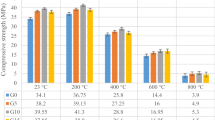Abstract
Over the last decade, new types of display technologies have increasingly replaced cathode ray tube (CRT) displays leading to an increase in the disposal of discarded old CRT monitors and TV sets. The present study is a further development of our previous work to explore the effects of using different size fractions of crushed CRT glass as 100 % substitution of sand in cement mortar. A range of cement mortar mixes were prepared and the tests conducted included table flow (fluidity), mechanical strength, drying shrinkage, alkali–silica reaction (ASR) expansion and toxicity characteristic leaching procedures. Generally, the results obtained for the CRT glass-based cement mortars were comparable to those of the beverage glass mortars except the hardened density due to the presence of lead in the CRT glass. Decreasing the particle size of the CRT glass led to a decrease in fluidity, compressive strength and water absorption. However, the use of finer glass particles slightly improved the flexural strength and reduced the risk of expansion due to ASR due to its pozzolanic reaction. The experimental results indicated that treated CRT glass can be utilized as 100 % replacement of sand in cement mortar regardless of its particle size.









Similar content being viewed by others
References
Lee CH, Chang CT, Fan KS, Chang TC (2004) An overview of recycling and treatment of scrap computers. J Hazard Mater 114:93–100
Lee CH, His CS (2002) Recycling of scrap cathode ray tubes. Environ Sci Technol 36:69–75
Pascal YG, François MO (2009) Lead extraction from waste funnel cathode-ray tubes glasses by reaction with silicon carbide and titanium nitride. J Hazard Mater 172:117–123
Townsend TG, Musson SE, Jang YC, Chung IH (2000) Characterization of lead leachability from cathode ray tubes using the toxicity characteristics leaching procedure. Environ Sci Technol 34:4376–4381
Poon CS (2008) Management of CRT glass from discarded computer monitors and TV sets. Waste Manag 28:1499
Ling TC, Poon CS, Kou SC (2011) Feasibility of using recycled glass in architectural cement mortar. Cem Concr Compos 33:848–854
Shi C, Zheng K (2007) A review on the use of waste glasses in the production of cement and concrete. Resour Conserv Recycl 52:234–247
Xie Z, Xi Y (2002) Use of recycled glass as a raw material in the manufacture of Portland cement. Mater Struct 35:510–515
Ling TC, Poon CS (2011) Properties of architectural mortar prepared with recycled glass with different particle sizes. Mater Des 32:2675–2684
Zhu H, Chen W, Zhou W, Byars EA (2009) Expansion behaviour of glass aggregates in different testing for alkali–silica reactivity. Mater Struct 42:485–494
Lee G, Ling TC, Wong YL, Poon CS (2011) Effects of crushed glass cullet sizes, casting methods and pozzolanic materials on ASR of concrete blocks. Constr Build Mater 25:2611–2618
Jin W, Meyer C, Baxter S (2009) Glasscrete—concrete with glass aggregate. ACI Mater J 97:208–213
Ling TC, Poon CS (2011) Utilization of recycled glass derived from cathode ray tube glass as fine aggregate in cement mortar. J Hazard Mater 192:451–456
ASTM C1437 (2007) Standard test method for flow of hydraulic cement mortar. American Society of Testing and Materials, West Conshohocken
ASTM C 642 (2006) Standard test method for density, absorption, and voids in hardened concrete. American Society of Testing and Materials, West Conshohocken
ASTM C348 (2008) Standard test method for flexural strength of hydraulic-cement mortars. American Society of Testing and Materials, West Conshohocken
ASTM C349 (2008) Standard test method for compressive strength of hydraulic-cement mortars (using portions of prisms broken in flexure). American Society of Testing and Materials, West Conshohocken
BS ISO 1920-8 (2009) Determination of drying shrinkage of concrete for samples prepared in the field or in the laboratory. British Standard Institution, London
ASTM C 1260 (2007) Standard test method for potential alkali reactivity of aggregates (mortar-bar method). American Society of Testing and Materials, West Conshohocken
Toxicity characteristic leaching procedure (TCLP), Test Method 1311 (1986). Specifications of the Committee on Analytical Reagents of the American Chemical. U.S. Environmental Protection Agency, Washington
Shi C, Wu Y, Riefler C, Wang H (2005) Characteristics and pozzolanic reactivity of glass powders. Cem Concr Res 35:987–993
Andreola F, Barbieri L, Corradi A, Lancellotti I (2005) Cathode ray tube glass recycling: an example of clean technology. Waste Manag Res 23:314–321
Acknowledgments
The authors would like to thank the Environment and Conservation Fund, the Woo Wheelock Green Fund, and The Hong Kong Polytechnic University for funding support.
Author information
Authors and Affiliations
Corresponding author
Rights and permissions
About this article
Cite this article
Ling, TC., Poon, CS. Effects of particle size of treated CRT funnel glass on properties of cement mortar. Mater Struct 46, 25–34 (2013). https://doi.org/10.1617/s11527-012-9880-8
Received:
Accepted:
Published:
Issue Date:
DOI: https://doi.org/10.1617/s11527-012-9880-8




